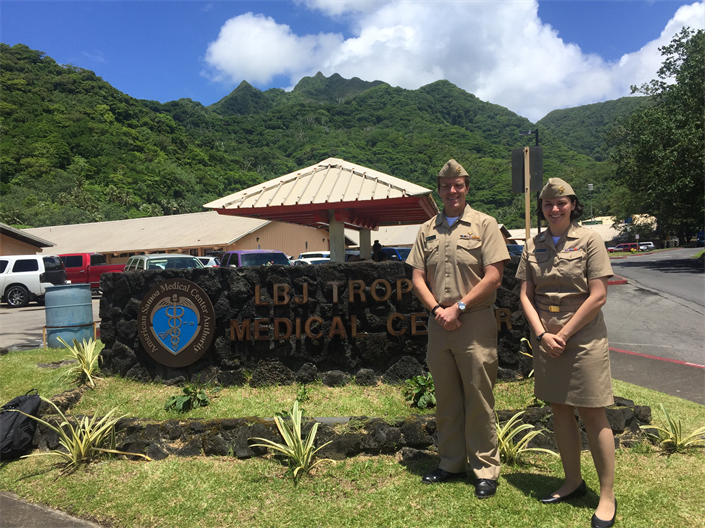2016 Deployment in Support of Zika Response in American Samoa
By LT Ruth Link-Gelles
Being a newly commissioned officer in the Commissioned Corps of the U.S. Public Health Service in summer 2016, I was eager to help with emergency responses, using skills I’d learned in my PhD program, as well as in my previous position at the Centers for Disease Control and Prevention, and at Officer Basic Course. When a co-worker asked for volunteers to deploy to American Samoa (AS) for CDC’s Zika response, I volunteered.
AS is a small island (population ~54,000) in the South Pacific and has been a U.S. protectorate since the early 1900s. It’s rich with culture and proud of its heritage, but suffers from a lack of much farmable land and, at only a few feet above sea level, is vulnerable to tsunamis, one of which killed more than 30 people in 2009. Perhaps the biggest barrier to health on the island, though, is its remote location. There is one hospital and, particularly problematic when dealing with Zika, only a single ultrasound machine and very few services for infants born with birth defects. Anyone with severe medical issues is usually referred off island to Hawaii (a 5 hour flight away), a time consuming and expensive trip.
After more than 24 hours of travel from Atlanta, I arrived in AS on a humid (that’s the only weather the island has) evening in early October and was met by the outgoing CDC epidemiologist, CAPT Paul Weidle (Pharmacist), and a couple other members of the CDC response team. The next week was a blur, trying to learn everything CAPT Weidle could teach me before his departure, meeting with AS Department of Health representatives, and figuring out where I could make the biggest impact in the month I had on island.
The Zika outbreak in AS started in early 2016, with a steep increase in cases, followed by a steady decline through April. Thankfully, by the time I arrived in October, it appeared that mosquito-borne transmission may have ended. But, women who were infected during the first trimester of pregnancy earlier in 2016, were beginning to give birth. Our efforts included ongoing testing of anyone with symptoms, as well as monitoring newborns for birth defects, and trying to increase services for babies born to Zika-positive moms.
Over the next month I got to know the territorial epidemiologist and his team, as well as a number of maternal and child health workers, lab workers, and others who were committed to the well-being of moms and babies on the island. Since AS is an American territory, we were in uniform the entire time, which started a lot of interesting conversations with locals, who are more used to seeing Army reservists at the local base, than the Navy khakis. I was frequently greeted as “Captain” and, while I appreciated the promotion, it gave me an opportunity to explain the Commissioned Corps and our mission (and how I was but a lowly Lieutenant).
I was fortunate while I was in AS to be mentored by a fantastic team of Commissioned Corps officers. In addition to CAPT Weidle, the team leads while I was there, CAPT Emily Piercefield (Physician) and LCDR Jason Wilken (Scientist), provided fantastic mentorship and have continued to guide me as I’ve worked to submit a conference abstract on our time there. I also became great friends with CDR Molly Evans (Physician) while we worked closely on the island. Our team truly reflected one of the greatest strengths of the Commissioned Corps, an interdisciplinary team committed to improving health.
As I think back on my time in AS, I’m reminded of an idea CAPT Daniel Beck impressed upon us at Officer Basic Course in August: The Commissioned Corps isn’t sexy. We’re not about parachuting from planes and helicoptering into war zones. We serve people who can’t get help elsewhere. People who are stuck by their circumstances, whether that be a natural disaster, poverty, or history. Our job is to improve their health and well-being when no one else will. Nothing could have been more accurate on American Samoa, a U.S. territory 4,900 miles from the mainland.


LT Link-Gelles on Zika deployment in American Samoa
Next Deployment Narrative Back to Deployment Narrative homepage